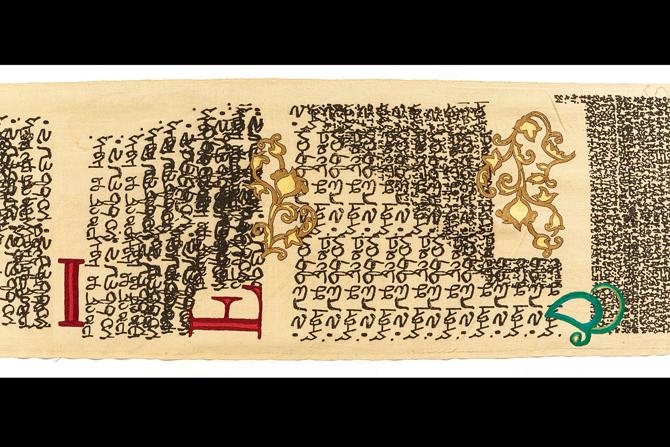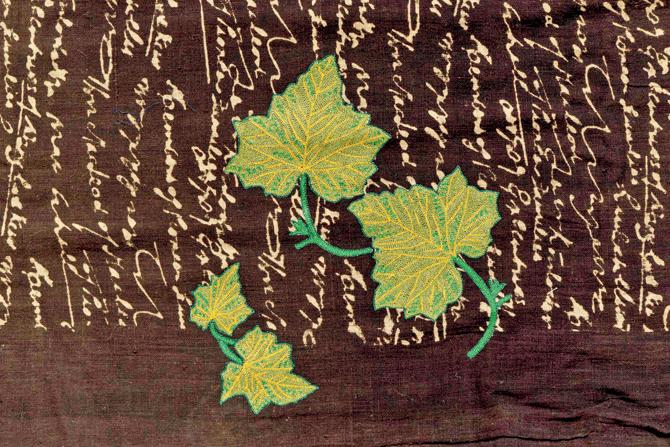Contemporary Australian artist Maggie Baxter's ongoing exhibition blurs the line between contemporary art and traditional Indian textile craft practices

Burst, Detail, Direct block printing with mineral dye on handwoven kala cotton, with hand stitch, 95.5 x 44.5 inches, 2019. pics/Maggie Baxter and Project 88, Mumbai
What happens when a contemporary artist from Australia, who largely produces abstract work, decides to connect with block printers from Kutch who don't speak English? In the case of artist Maggie Baxter, the answer is a solo art exhibition.
ADVERTISEMENT
A textile artist and public art curator, Baxter has been returning to India, especially Kutch, since 1990. These visits have inspired her to create several group and solo exhibitions in the past that merge the beauty of the many embroideries and block printing styles of Kutch with her practice. Her latest show, titled Blurred Lines, pushes this conversation between cultures forward.

No-Stro-Phe, Detail, Direct block print with mineral dye on hand woven kala cotton, Ari embroidery, silk backing, 230 x 16 inches, 2018
Presented at Project 88 in collaboration with the Australian Consulate-General in Mumbai and the Government of Western Australia, Baxter began to toy with the idea of Blurred Lines on a trip to Udaipur, where she visited a shop that sold notebooks and journals. A pile of old ledgers filled with unintelligible writings got Baxter thinking as she had always been interested in the script. In fact, she had even worked on a series of photographs on graffiti walls with peeling paint during her student days in 1980.

Maggie Baxter
"I have been working in different ways with script and graffiti. I am intrigued for long by words and scripts, irrespective of whether they are the finest manuscripts or simply written on a wall," explains Baxter. The basis of her pieces are blurred block prints of phrases taken from different texts — most words, according to her, are out of context but somehow reflect her practice — with more text embroidered using ari hand embroidery, also from Kutch. One such phrase is, 'The economic advantages of mechanisation have not proved irresistible' that she spotted in an obscure book called Bitten by Witch Fever: Wallpaper and Arsenic in the Victorian Home inside a gallery in Melbourne.

The Grammar of Ornamentation Is Never Sufficiently Abstract, Detail, Resist block print with mineral dye on handwoven cotton, Ari hand embroidery, 98.5 x 33.5 inches, 2019
While the book speaks about arsenic being used to produce bright colours in wallpapers and how it leads to deaths, Baxter uses this reworked phrase that is hand-embroidered as a comment on mechanisation leading to the loss of handicraft practices such as the ari embroidery. "I have been using pakko embroidery, which is raised and heavy, as my main medium for ages. But I was fascinated by ari and how it's used for illustrative work. I kept wondering how I could incorporate it in my work, which is 90 per cent abstract. This show, like my other works, blurs the lines between craft and fine art," explains Baxter.

Q?, Resist block printing with mineral dye, on handwoven kala cotton, Ari embroidery, 94 x 34 inches, 2019
Baxter has also used handwoven kala cotton from Kutch as one of her mediums, as it is slightly rough and gives the image of a parchment when block printed with text. She admits that the show wouldn't have been possible without help from Indian artisans, and her long association with the Shrujan Trust. For this exhibition, Baxter has once again worked with her friend, artist Kirit Dave, primarily on the block printing aspect. Dave translated her concept to the artisans and helped Baxter realise her vision of using traditional craft practices for a contemporary expression. "I have been doing this [working with craftsmen from Kutch] for 30 years. Today, artisans are far more aware of modern and traditional craft practices on a global platform as they tend to get invited to travel and showcase their work. It's a joy to experience another culture, and even though it was not intentional for the dialogue between cultures to be a part of the narrative of this exhibition, it did become a part. The more I return, the more I get involved in it," she sums up.
From: Today, till September 7
At: Project 88, BMP building, near Colaba Fire Station, Colaba.
Call: 22810066
Catch up on all the latest Crime, National, International and Hatke news here. Also, download the new mid-day Android and iOS apps to get the latest updates
 Subscribe today by clicking the link and stay updated with the latest news!" Click here!
Subscribe today by clicking the link and stay updated with the latest news!" Click here!






